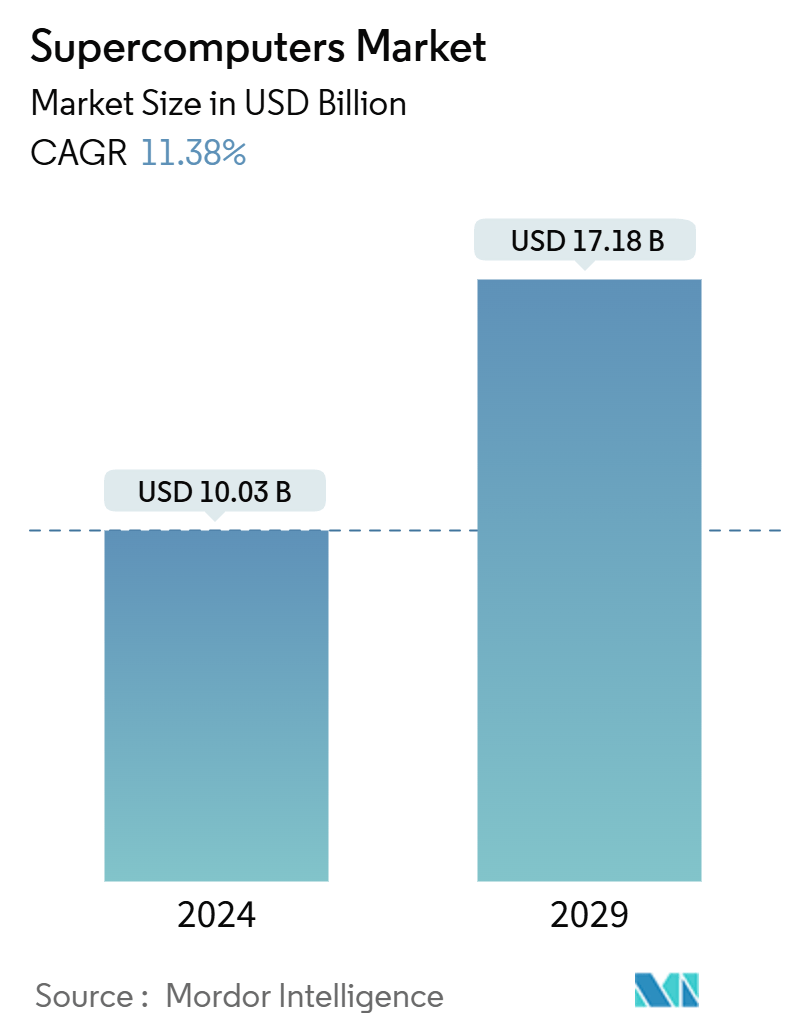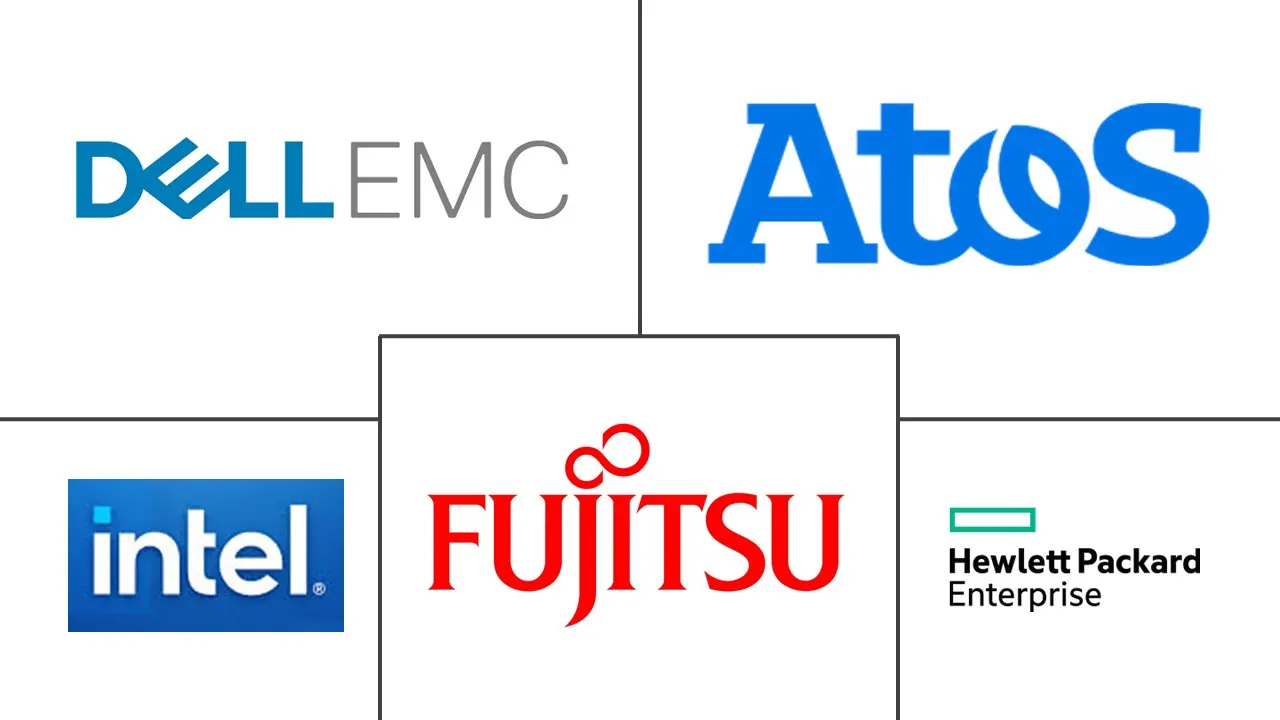Market Size of Supercomputers Industry

| Study Period | 2019 - 2029 |
| Market Size (2024) | USD 10.03 Billion |
| Market Size (2029) | USD 17.18 Billion |
| CAGR (2024 - 2029) | 11.38 % |
| Fastest Growing Market | Asia Pacific |
| Largest Market | Middle East and Africa |
| Market Concentration | Medium |
Major Players
*Disclaimer: Major Players sorted in no particular order |
Supercomputers Market Analysis
The Supercomputers Market size is estimated at USD 10.03 billion in 2024, and is expected to reach USD 17.18 billion by 2029, at a CAGR of 11.38% during the forecast period (2024-2029).
Supercomputers, with their high-performance processing capabilities, are increasingly becoming the backbone for running artificial intelligence (AI) programs. Their architecture is adept at handling the extensive data requirements of AI and machine learning applications.
The Growth In The Usage Of High-performance Computing (HPC) Applications Worldwide Will Drive The Market
- Supercomputers, known for their immense computational power and speed, play a crucial role in high-performance computing (HPC) systems. Their capabilities make them indispensable in the HPC landscape. With scientific research leaning more towards simulation-based techniques and the rising importance of machine learning (ML), the market demand for supercomputers has seen a notable uptick.
- Additionally, in October 2024, NVIDIA's shares reached an all-time high, fueled by rising optimism regarding the robust demand for its latest supercomputing AI chips, Blackwell. This underscores the promising growth trajectory of supercomputers, bolstering the overall market expansion.
- As organizations grapple with complex data sets and analytics workloads, the demand for supercomputers will rise. Supercomputers are now becoming more accessible and cost-effective for educational research institutions. Furthermore, the growing trend of democratizing computing power, especially through cloud-computing-enabled platform-as-service models, is set to boost the market further.
The High Initial Cost Of Supercomputing Systems Is The Major Hindrance To Market Growth
- High ownership costs, encompassing the device's price, housing infrastructure, and operational expenses, render supercomputers expensive and challenge market growth. For example, in March 2024, Microsoft and OpenAI collaborated to build an AI-based supercomputer costing approximately USD 100 billion. This shows that such supercomputers cater predominantly to large corporations, making them unfeasible for small and medium-sized enterprises.
The Impact Of Geopolitical Conflicts Among Countries Can Impact The Market Growth
- The demand for supercomputers in defense departments to increase cyber defense and attack supports the government sector's market growth. Additionally, in April 2024, a cybersecurity official at the US State Department detected unusual activity, revealing that China had developed a quantum supercomputer. This advancement can destroy all Western encryption, thereby nullifying their cyber defenses.
Supercomputers Industry Segmentation
Supercomputers outpace standard computers in processing speed thanks to their multiple processors. This design facilitates rapid circuit switching, allowing users to access and process vast amounts of data swiftly.
The supercomputer market is segmented by end users (commercial industries, government entities, and research institutions) and geography (North America, Europe, Asia Pacific, Latin America, and Middle East & Africa). The market sizes and forecasts are provided in terms of value in USD for all the above segments.
| By End User | |
| Commercial Industries | |
| Government Entities | |
| Research Institutions |
| By Geography*** | |
| North America | |
| Europe | |
| Asia | |
| Australia and New Zealand | |
| Latin America | |
| Middle East and Africa |
Supercomputers Market Size Summary
The supercomputer market is experiencing a transformative phase, driven by the integration of cloud technology and the increasing demand from diverse sectors such as education, research, and government. Cloud solutions are reshaping the supercomputing landscape by offering scalable applications without the need for specific architectures, making supercomputing more accessible to organizations beyond large enterprises. This shift is particularly evident in educational and research institutions, which are increasingly leveraging supercomputing capabilities to handle complex data sets and analytics workloads. Supercomputers are crucial for conducting comprehensive simulations, reducing the need for physical testing, and are instrumental in advancing research and enhancing national security. However, the market faces challenges such as high installation and maintenance costs, energy consumption, and space requirements, which necessitate specialized oversight and problem-detection applications.
The Asia-Pacific region is rapidly emerging as a key player in the supercomputer market, with significant developments in countries like China, Japan, and India. These nations are investing heavily in supercomputing infrastructure to bolster their technological capabilities and competitiveness. The market is semi-consolidated, with a few major players like HPE, Atos SE, Dell Inc., FUJITSU Corporation, IBM Corporation, Lenovo Inc., and NEC Technologies India Private Limited holding significant market shares. Recent advancements include the delivery of high-efficiency supercomputers and the development of next-generation systems aimed at enhancing predictive accuracy and supporting scientific discovery. The growing demand for data-driven decision-making, coupled with the need for rapid and precise data processing in sectors like healthcare, is further propelling the market's growth.
Supercomputers Market Size - Table of Contents
-
1. MARKET INSIGHTS
-
1.1 Market Overview
-
1.2 Industry Value Chain Analysis
-
1.3 Industry Attractiveness - Porter's Five Forces Analysis
-
1.3.1 Bargaining Power of Suppliers
-
1.3.2 Bargaining Power of Buyers
-
1.3.3 Threat of New Entrants
-
1.3.4 Threat of Substitute Products
-
1.3.5 Intensity of Competitive Rivalry
-
-
1.4 Assessment Of The Impact Of Macroeconomic Factors On The Market
-
-
2. MARKET SEGMENTATION
-
2.1 By End User
-
2.1.1 Commercial Industries
-
2.1.2 Government Entities
-
2.1.3 Research Institutions
-
-
2.2 By Geography***
-
2.2.1 North America
-
2.2.2 Europe
-
2.2.3 Asia
-
2.2.4 Australia and New Zealand
-
2.2.5 Latin America
-
2.2.6 Middle East and Africa
-
-
Supercomputers Market Size FAQs
How big is the Supercomputers Market?
The Supercomputers Market size is expected to reach USD 10.03 billion in 2024 and grow at a CAGR of 11.38% to reach USD 17.18 billion by 2029.
What is the current Supercomputers Market size?
In 2024, the Supercomputers Market size is expected to reach USD 10.03 billion.

